
Waterproof without fluorocarbons
Performance meets Ecology
We haven’t used C8 technologies in our Apparel Collection since the Summer 2015 Collection.
In the Summer Season 2018 we successfully transitioned our entire VAUDE Apparel Collection to becoming PFC-free by using VAUDE Eco Finish. A major portion of the rest of the product range in this collection also has fluorocarbon-free waterproofing.
Fluoro-what? What's the problem with fluorocarbons anyway?
To put it simply:
Fluorocarbons do not occur naturally on our planet. These are polyfluorinated or perfluorinated compounds, also referred to as PFC or PFOS. They were invented in the 1960s and have been used since then for a variety of applications, for example as a chemical finish on textiles to make them waterproof, stain resistant and oil repellent. PFCs are also used in many other industrial areas.
Man-made hazardous substances
The real problem is that it was subsequently discovered that PFCs are harmful to the environment and to human health. For example, PFOA (perfluorooctanoic acid) is one of the most dangerous substances.
It does not occur in nature, but it has now been found in breast milk, the blood of polar bears, in glaciers, on every continent of the planet and even in our drinking water in Germany.
Origins and distribution of PFCs
PFOA is created during a production process that involves C8 technology. C8 stands for eight carbon atoms (carbon = C). Grossly simplified, these carbon atoms are replaced by fluorine atoms (all = per, some = polyfluorinated). This makes an extremely stable and dangerous molecule – PBT substance:
- P = persistent: does not degrade, or degrades very slowly
- B = bioaccumulative: accumulates in the body through the food chain, usually in the blood or in the liver.
- T = toxic
Not exactly a chemical you want to have around. There are many studies about the serious health consequences of PFC in the body, including cancer.
The global water cycle transports PFCs everywhere
If a rain jacket has been proofed with C8, traces of PFOA can be found in it. Whether or not, this is dangerous for the wearer or the degree to which it might be, is still being debated. But in any case, it is clear that in the manufacturing process of PFC and the materials treated with it, PFC escapes into the environment, primarily by means of industrial wastewater.
Because all of the earth’s water is moving around in a huge, endless cycle of evaporation, precipitation, ocean currents, and so on, PFC is spread around the planet. We've known this for a long time, but it was the Greenpeace Detox Campaign that first raised the public’s awareness of the issue.
The EU is considering a ban on perfluorooctanoic acid (PFOA), but so far, the only country to have legal limits is Norway. In the rest of the world, PFCs continue to be processed legally.
Therefore, we believe that it is all the more important for us to take on responsibility as an outdoor brand and to voluntarily eliminate the use of all PFCs in our products as quickly as possible.
Waterproofing is important
We need waterproofing: Textile surfaces are waterproofed with durable water repellency (DWR) to repel water and dirt. Without this surface treatment, the outer fabric would absorb rainwater and feel damp, even if the product had a waterproof membrane. In extreme rain conditions water could even be absorbed into the inner surface of the shell and your inner jacket could become wet.
In the past, it was virtually impossible from a technological standpoint to produce an equivalent high-performance waterproofing agent without PFCs. Thanks to today’s innovative technologies, this is no longer a problem for most fabrics.
The fact is, however, that oil repellency on fabrics is achieved only with the help of PFC. We have thoroughly examined the issue of whether outdoor products really need this feature and decided that for VAUDE, they do not – for the sake of the planet and the people who live on it. It is also a fact that fluorocarbon-free DWRs are often not as durable as conventional PFC-containing versions. Re-waterproofing is therefore necessary after washing, naturally with a fluorocarbon-free waterproofing agent. You should always take a look at the care label of your product where you can find instructions on how to best care for it. More information about proper product care can be found here.
VAUDE has taken on responsibility and has voluntarily undertaken a commitment to manufacture its entire product range completely PFC-free by the year 2020, and the Apparel Collection by 2018.
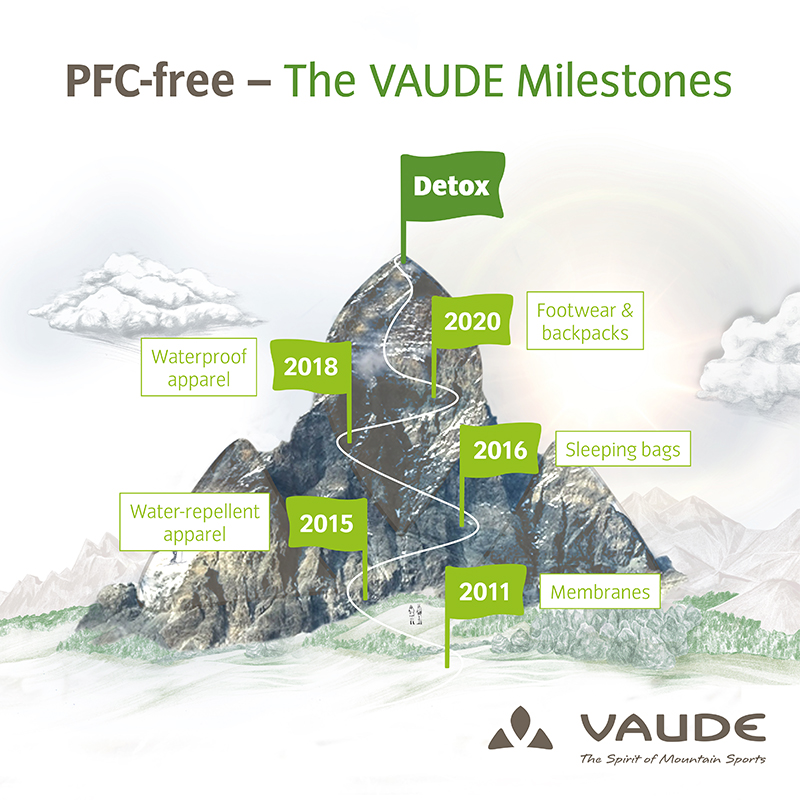
Green Shape Eco Finish - Movie:
Rigorous testing for PFC-free products: Spray Test and the Bundesmann test
Ruling for Eco Finish. Example: Cyclist Jacket
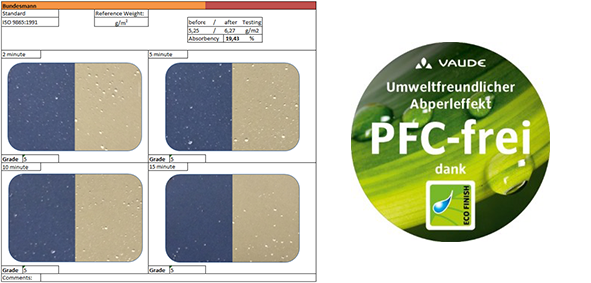
Ruling against Eco Finish. Example: Escape Light Jacket – up to Summer 2017 Collection:
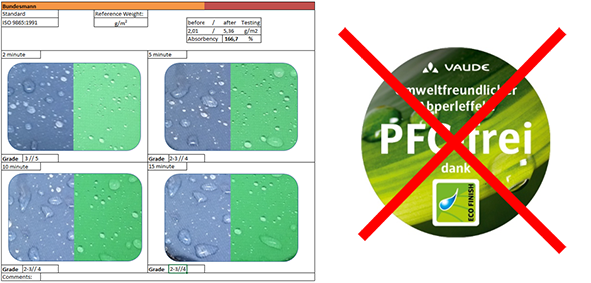
New ruling on Eco Finish. Example: Escape Light from Summer 18:

Our procedure can be clearly explained using the Escape Light Jacket as an example. Until summer 2017 the water absorption levels in our tests were too high, so we didn’t transition to an Eco Finish fabric for this collection.
We then worked intensively with our fabric supplier and the DWR supplier on the functionality of the fabric and have now achieved significantly lower water absorption levels. As a result, the fabric has been PFC-free since the Summer 2018 Collection.
This has been a long and complex process that we have only been able to pursue together with the manufacturers of our materials and DWR and with experts from universities and industrial associations. We only introduce materials into our collection that offer full functionality. After all, nobody like getting wet either…
Great success, great challenges
We are proud of the fact that we have now successfully transitioned to PFC-free DWRs for many of our materials.
Since the 2018 Summer Collection, all waterproof and water-repellent clothing products have featured PFC-free Eco Finish as standard. This is a great success and a breakthrough for VAUDE.
But nobody is perfect... We are still struggling with challenges in daily practice. For example, we had a bitter pill to swallow with two other jacket models and one pair of pants: although the fabrics with Eco Finish had passed all laboratory tests, the product samples did not meet our requirements during wear testing (e.g. ski tours or winter biking in wet weather). Therefore, these products will have PFC (C6) again for the time being and we are working diligently to ensure adequate performance levels with Eco Finish next season.
The only hurdle yet to be faced – some of our suppliers have not yet been able to produce waterproof zips without PFC.
Percentage of waterproof and water repellent products per season and product range with Eco Finish (PFC-free)
Create your own infographicsEco Finish stands for performance
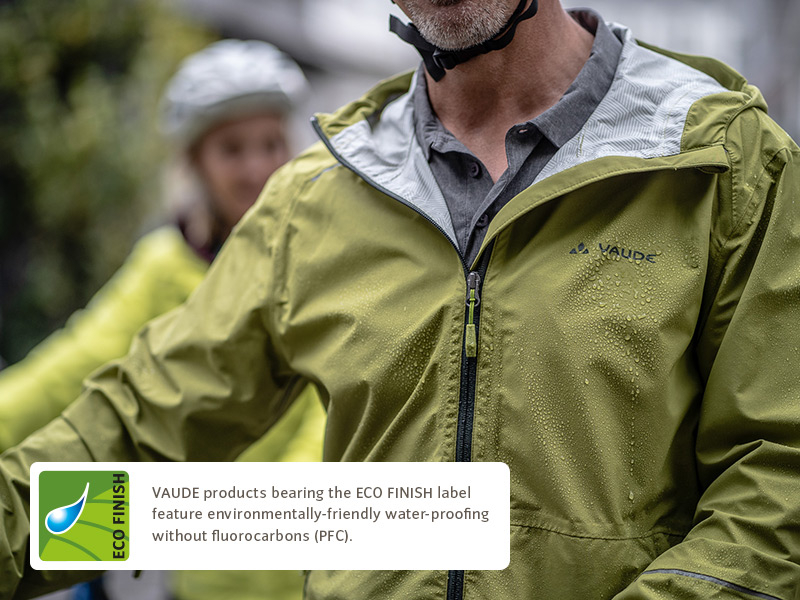
Together with our suppliers, we draw on a full portfolio of fluorocarbon-free alternatives that have proven reliable on our materials. Since not every technology functions equally well on each kind of material, we have a variety of options from different suppliers.
VAUDE Eco Finish covers all fluorocarbon-free technologies that are used in our VAUDE products.
Our VAUDE webshop has a special filter so that you can easily find our PFC-free products.
C6 PFC as a transitional technology
We use C6 DWR to waterproof the products for which we have still not found an Eco Finish DWR that works well.
C6 is considered to be a more environmentally friendly alternative to C8. It contains six carbon atoms and does not create PFOA. But because C6 has shorter molecule chains, it is more mobile and spreads faster than C8 via the global waterways. It is really only a stop-gap technology that we want to replace with Eco Finish as soon as possible.
At VAUDE this technology still applies to tents and some footwear models.
The VAUDE Manufacturing Restricted Substance List (MRSL) sets prohibitions and strict limits on the use of chemicals and applies to VAUDE products. The bluesign® system also has strict regulations on the use of PFC.
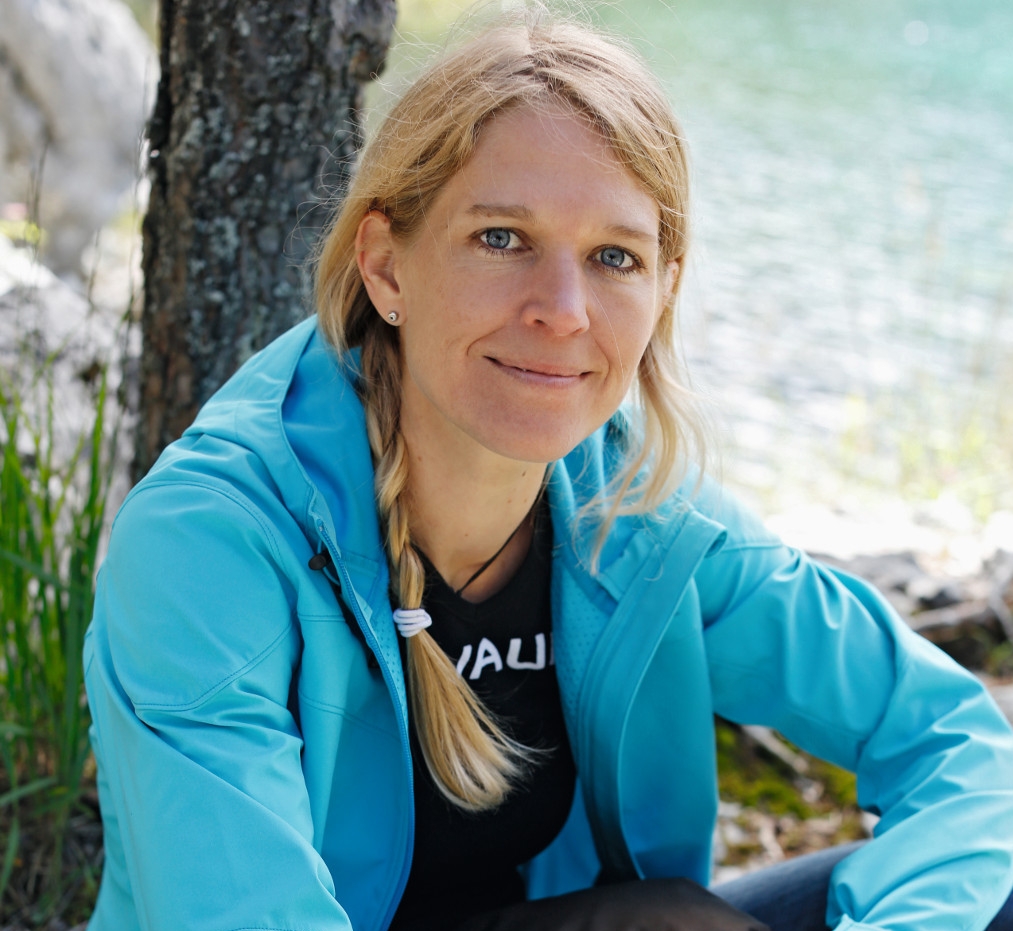
»It was a feat, but we are proud of the fact that we have already been successful in switching many of our materials to PFC-free DWR: From the Summer 2018 Season, we will use Eco Finish throughout the entire Apparel Collection. «
| GRI: | 301-1 |




